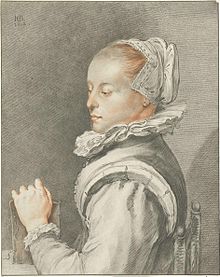Maria Tesselschade Visscher
Maria Tesselschade Visscher | |
|---|---|
 | |
| Born | Maria Tesselschade Roemers Visscher 25 March 1594 |
| Died | 20 June 1649 (aged 55) |
| Nationality | Dutch |
| Known for | Poetry Engraving |
| Movement | Dutch Golden Age |
| Spouse | Allard Crombalch (1623-1634) |
| Elected | Muiderkring |
Maria Tesselschade Roemers Visscher, also called Maria Tesselschade Roemersdochter Visscher or Tesselschade (25 March 1594 – 20 June 1649) was a Dutch poet and engraver.
Life
Tesselschade was born in Amsterdam, the youngest of three daughters of poet and humanist Roemer Visscher.[1] She was given the name Tesselschade ("Damage on Tessel"), because her father lost ships near the Dutch island Texel on Christmas Eve 1593, three months before her birth, to remember that 'worldly wealth could be gone instantly.'

She and her sister Anna Visscher were the only women members of the Muiderkring, the group of Dutch Golden Age intellectuals who met at Muiden Castle. She is often characterised as a muse of the group and attracted the admiration of its members, such as its organiser Hooft, Huygens, Barlaeus, Bredero, Heinsius, Vondel and Jacob Cats.
In their correspondence, she is described as attractive, musically talented, and a skilled translator and commentator from French and Italian.[2] They also praised her skill at singing, painting, carving, etching on glass and tapestry work.[3] The Rijksmuseum Amsterdam has an example of her engraving work, a römer drinking glass engraved with the motto Sic Soleo Amicos ("this is how I treat my friends").[4]
In 1623, she married a ship's officer, Allard Crombalch. After he died in 1634, Huygens and Barlaeus proposed marriage to her, offers she rejected.
In remembrance of Tesselschade there are several streets named after her, such as the Tesselschadestraat or Tesselschadelaan in Alkmaar, Eindhoven, Amsterdam, Zwolle, Leiden and Leeuwarden.[citation needed]
References
- ^ "MARIA TESSELSCHADE ROEMER VISSCHER (1593-1649)". Canadian Association for the Advancement of Netherlandic Studies. Issue XI, 1990.
{{cite journal}}:|volume=has extra text (help) - ^ The Embarrassment of Riches: An Interpretation of Dutch Culture in the Golden Age, Simon Schama, HarperCollins, 1987, ISBN 0-00-217801-X
- ^ History of Holland, George Edmundson, Cambridge University Press, 1922 ebook, ebooksread.com Archived 2007-09-27 at the Wayback Machine
- ^ "Roemer, Anonymous, c. 1625 - c. 1650". Rijksmuseum. Archived from the original on 2012-10-10. Retrieved 2007-08-01.
Further reading
- Lennep, J, Herman F. C. Kate, and W P. Hoevenaar. Galerij Van Beroemde Nederlanders Uit Het Tijdvak Van Frederik Hendrik. Utrecht: L.E. Bosch en Zoon, 1868.
External links
- Maria Tesselschade Visscher - digital version of all her poems (in Dutch)
- Visscher, Tesselschade Roemersdr., Digitaal Vrouwenlexicon van Nederland (in Dutch)
- 1594 births
- 1649 deaths
- 17th-century Dutch poets
- 17th-century Dutch women writers
- 17th-century writers
- Dutch women poets
- Dutch engravers
- Muiderkring
- Writers from Amsterdam
- Dutch Golden Age writers
- Burials at the Oude Kerk (Amsterdam)
- Dutch women artists
- Glass engravers
- Women engravers
- 17th-century engravers
- 17th-century women artists
- Italian–Dutch translators
